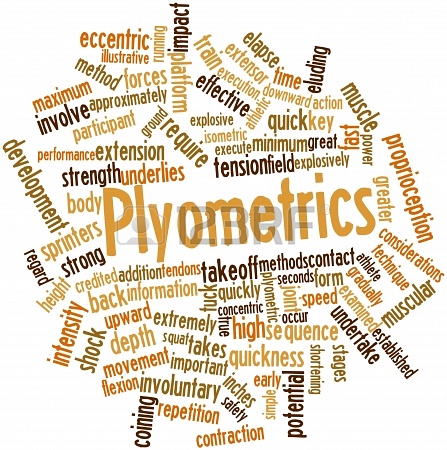The word “plyometric” comes from the Greek word pliometric (“plio” meaning increase and “metric” meaning measure), meaning “to increase the measurement.”Plyometric exercise is defined as a lengthening of the muscle-tendon unit followed directly by a shortening of the muscle-tendon unit. To put it simply, you are quickly putting a stretch on a muscle before quickly contracting or shortening the same muscle. This stretch-shortening cycle enhances the ability of the muscle-tendon unit to produce maximum force in the shortest time. Typically in physical therapy, plyometric exercises are initiated at a low intensity and progressed to a high intensity as the athlete or patient becomes stronger. Progression to higher intensity exercises are thought to prepare the musculoskeletal system for rapid movements and high forces, which are similar to the demands the athlete will face with return to sport. Examples of typical plyometric exercises include jumping drills, landing drills, and lateral cutting maneuvers.
Plyometrics is a training technique designed to increase muscular power and explosiveness. Originally developed for Olympic athletes, plyometric training has become a popular workout routine for people of all ages, including children and adolescents.
Because plyometric exercises mimic the motions used in sports such as skiing, tennis, football, basketball, volleyball, and boxing, plyometric training often is used to condition professional and amateur adult athletes. But children and adolescents also can benefit from a properly designed and supervised plyometric routine, according to the American College of Sports Medicine.
But plyometric training is also associated with some risks, including an increased risk of injury, especially in participants who don’t have adequate strength to begin with. So if you’re considering plyometrics, it’s important to consult with a sports medicine doctor or physical therapist who can assess your suitability for a plyometrics training program, and then select a qualified coach or trainer who can gradually introduce you to more difficult exercises.
Phases of plyometric exercise
Loading
The first phase of plyometric exercise is called the loading phase. Some researchers refer to this phase as the eccentric, deceleration, yielding, or cocking phase. Regardless of the name, during this phase is when the muscle-tendon unit of the muscle is stretched as load or kinetic energy is applied to the joint. This may occur as an athlete is in flight from a previous jump or if an athlete is preparing to catch a heavy load. Stretching of the muscle-tendon unit elicits a stretch in certain muscle receptors which will create movement, and also store elastic potential energy.
Coupling
The transition between loading and unloading phases is called the coupling phase. The coupling phase is, for all intents and purposes, when there is an isometric contraction of the muscle. This means that for the most part, the muscle does not change in length despite changes in the joint angle, vertical ground reaction force, or the athlete’s center of mass.
Unloading
The phase immediately after the coupling phase is called the unloading phase. This phase is also known as the rebound, shortening, or push-off phase. During this phase, the muscle-tendon unit begins to shorten.
Momentum
Plyometric activities terminate in this phase. This is when the body segment continues to move as a result of the forces generated during the unloading phase (i.e. continued upward motion during a jump).
Benefits of plyometrics include:
- Improved coordination
- Improved stress and load tolerance in the body
- Improved reaction time
Remember that plyometric exercise is an advanced form of exercise and is used only during the late stages of your rehabilitation. If you start plyometric training too early in the healing process, you may cause re-injury or a repetitive strain injury.
When starting plyometric type exercises, make sure that you have good range of motion (ROM) and strength in the body parts that are to be trained. Your physical therapist can measure your ROM and strength and offer suggestions to ensure safety during plyometrics. Be sure to follow the advice of your doctor or physical therapist before starting any plyometric exercises.
A few guidelines should be followed to ensure safety.
- Be sure that the activity you are performing mimics the functional activity you wish to return to. For example, if you wish to return to basketball after an ankle fracture, you would start plyometric exercises that include jumping.
- Be sure that an appropriate amount of muscle strength and endurance has been achieved before starting plyometrics.
- Always warm up before starting plyometric exercises.
- The exercise should be performed as quickly as possible to improve reaction time and agility.
- Start plyometric exercises bilaterally. That is, in the lower body, both legs should do the exercise together; in the upper body both arms do the exercise. Progress to single leg or arm plyometrics after the exercises feel easier.
- Resistance may be added with weights or rubber tubing, but caution should be used to prevent injury from using too much resistance.
Plyometrics can be an excellent form of exercise to improve power, strength, muscular endurance and reaction time. If you are planning to return to high-level athletics or work activities, plyometric training can help ensure that you are ready to proceed to normal function.
If you have suffered an injury, be sure to ask your doctor or physical therapist if plyometric training is appropriate in your rehabilitation program.
Reference:
Beantown Physio http://www.beantownphysio.com/pt-tip/archive/plyometric-exercise.html
WebMD http://www.webmd.com/fitness-exercise/guide/plyometrics-exercise-workouts
About.com http://physicaltherapy.about.com/od/abbreviationsandterms/g/Plyometric-Exercise.htm

